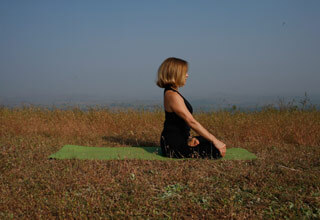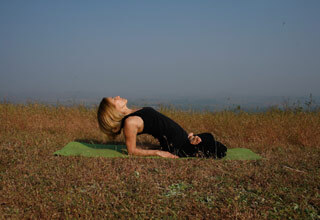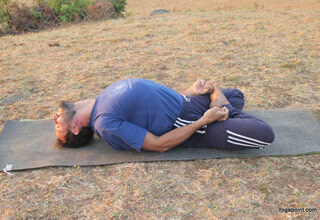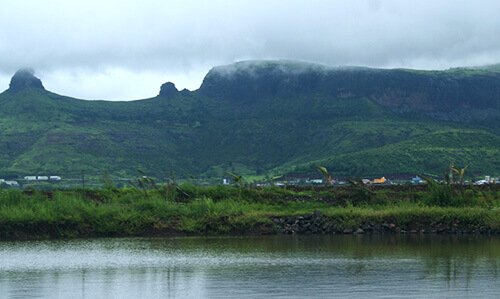The Matsya bandha causes a stretching on the thyroid and parathyroid glands, thereby improving their function and counterbalancing the effects of the Jalandhar bandha. It stretches the intestines, liver, pancreas, bladder and other abdominal organs which improves their functioning and efficiency. Reduces blood supply to the legs and redirects it to the reproductive and pelvic organs. Stagnant blood around vertebral column is drained. Improves supply to brain and face, also stretches the carotid artery. The reproductive system is improved due to the increased blood supply. Toning of abdominal, thigh and intercostal muscles. Toning of intercostals muscles help in deep breathing, so it is helpful in asthma and bronchitis. It opens up the chest and lungs. Haemorrhoids. Increases circulation to the back which helps in backache and cervical spondylitis. Boosts the immune system due to its effect on the thymus gland. Loosens the spine and prevents round shoulders. Loosens the legs and prepares them for meditation poses.




Beneficial for reproductive organs.
Asthma. Bronchitis. Reproductive disorders. Cervical spondylitis. Haemorrhoids. Back pain.
In supine position bend the legs into cross-legged position or ideally come into padmasan - lotus pose by spreading your legs a little more than hip-width apart. Bend one leg and place it on the opposite thigh. Bend the other leg and place it on the opposite thigh. With the support of the elbows raise the head, curve the neck backward and place the top of the head on the floor creating an arch in the back. If you are in padmasan - lotus pose try to hold the toes of the feet with opposite hands,otherwise rest the hands on the abdomen or thighs and breathe normally.
To release the asana release the toes. Using the support of the elbows, slowly release the neck and return the shoulders and head to the floor. Straighten the legs. Bring both legs together, returning to the supine position.
Neck, head, throat, chest, hips, back, legs.
On core area and throat
While taking and releasing the position, support the neck with the elbows or the hands. Try to rest the crown of the head on the ground. Hold the toes or if that is difficult place the hands on the thighs or ground.
Move, overstretch or turn the neck while you are in the position. Overstretch the neck. Come into or out of the position fast.
Should not be performed by people suffering from high blood pressure, heart diseases, hernia or ulcers. Should be avoided during menstruation and pregnancy.
One can keep the legs straight instead of being in Padmasana. The legs can be folded in Swastikasana or Samasana or a simple cross legged position. To begin with, or if the neck is delicate, then it is better to place the hands next to the head before placing the crown of the head on the floor. This gives more support to the head and neck than the elbows do.
Sarvangasan, Halasan, Ashwini Mudra, Karnapeedanasan are all poses that are often practiced before matsyasan.
Shavasan. Chakrasan.
Supine
Phone - +91-9822770727
E-mail - yoga@yogapoint.com or yogapoint108@gmail.com

Yoga Vidya Dham, Kaivalya Nagari,
College Road, Nashik - 422005.
Maharashtra, India.
Phone - +91-9822770727 (for courses in ENGLISH)
+91-253-2318090 (For courses, in HINDI or MARATHI)
(Please call during 9.00 AM to 5 PM Indian Time)
E-mail - yoga@yogapoint.co or yogapoint108@gmail.com
Village Talwade, Trimbak, Nasik
Maharashtra,India.
Phone - +91-9822770727
E-mail - yoga@yogapoint.com or yogapoint108@gmail.com
